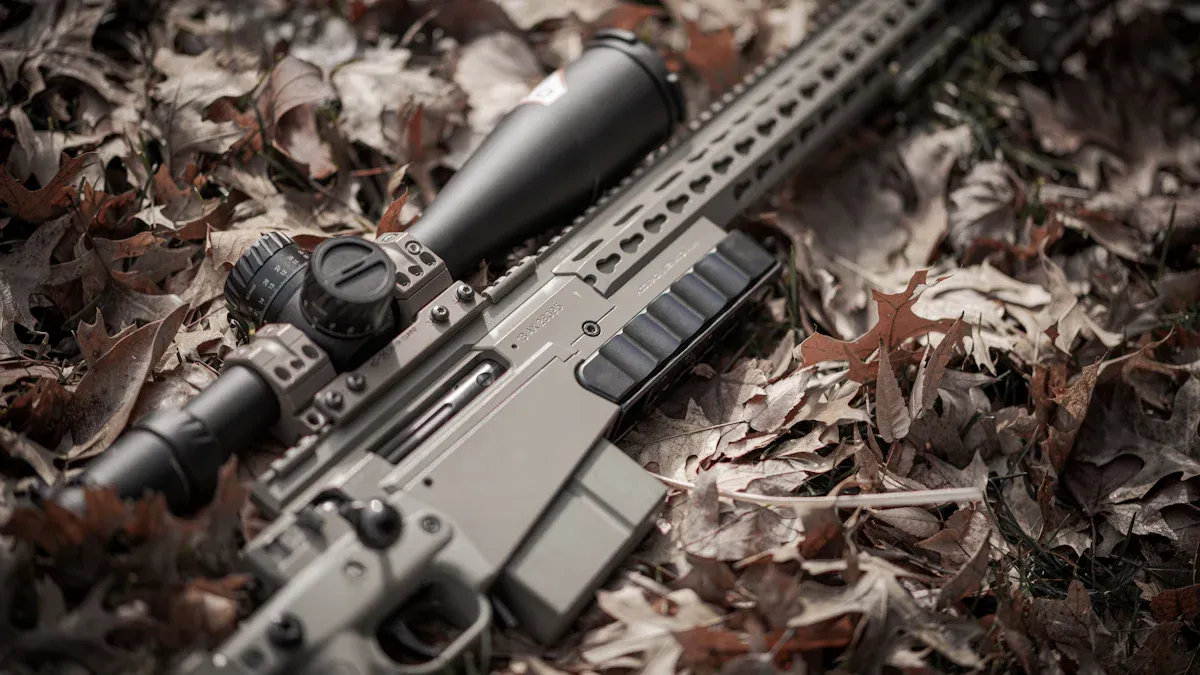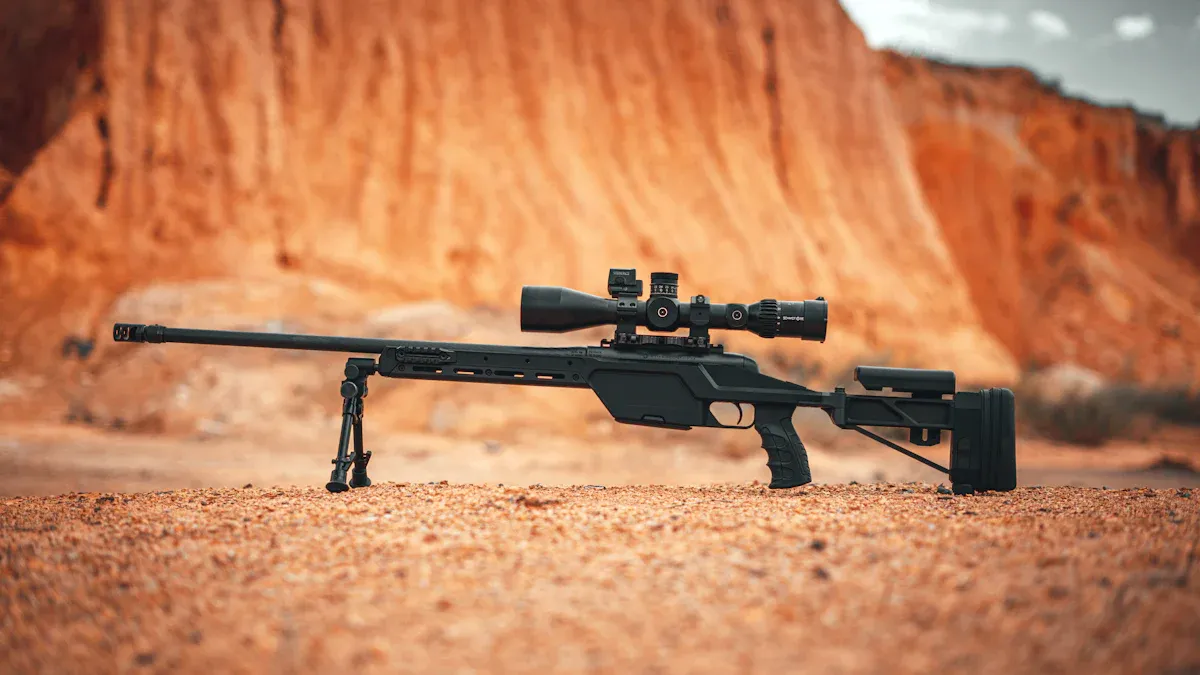
Hunters rely on lightweight rifle bipods to enhance stability and accuracy during critical moments. These tools minimize movement, allowing precise shots even in challenging conditions. Modern designs, such as the Spartan Javelin Lite and MDT Ckye-Pod, offer quick deployment and versatile shooting positions. Their portability reduces fatigue, while durable materials ensure reliability. Accessories like a rail mount further improve compatibility with various rifles and rifle scopes, making them indispensable for hunters seeking performance and convenience.
Key Takeaways
- Pick light bipods to carry easily and avoid getting tired.
- Find strong materials like aluminum or steel for tough outdoor use.
- Get a bipod with legs you can adjust and that fits your rifle. This helps with balance on different grounds.
Key Features to Look For in a Lightweight Rifle Bipod
Weight and Portability
Weight plays a crucial role in determining the portability of a rifle bipod. Lightweight options are ideal for hunters who need to move frequently across rugged terrains. They reduce fatigue during long hunting sessions and allow for easier handling. However, heavier bipods provide greater stability, which is essential for precision shooting. For instance, competitive shooters often select lightweight bipods to maintain portability without compromising performance. Hunters using lighter caliber rifles may also benefit from these models, as they balance portability and stability effectively.
Durability and Material Quality
The material quality of a rifle bipod directly impacts its durability and performance. Premium bipods, often made from aluminum or steel, offer excellent longevity and withstand harsh outdoor conditions. Reviews highlight the MDT Ckye-Pod for its robust build and long-lasting performance. Investing in a high-quality bipod ensures reliability during critical moments in the field. Additionally, hands-on testing confirms that durable materials enhance stability, making them a preferred choice for long-range shooting.
Adjustability and Height Range
Adjustability is a key feature for adapting to various shooting positions and terrains. Many bipods, such as the Atlas PSR, offer adjustable leg heights starting from 5 inches. Features like leg locking at multiple angles and the ability to cant or pan improve versatility. The MDT Ckye-Pod, with its double-pull system, adjusts from 9.5 to 18 inches, catering to different shooting scenarios. Hunters value these features for their ability to quickly adapt to uneven surfaces or obstacles.
Attachment Types and Compatibility
Compatibility with a rifle’s attachment system is essential for seamless integration. Bipods typically attach via swivel studs, Picatinny rails, or M-LOK systems. Choosing the right attachment type ensures stability and ease of use. For example, the Vanguard Scout B62 offers versatile mounting options, making it suitable for various rifle models. Hunters should verify compatibility with their rifle’s existing setup to avoid issues in the field.
Top Lightweight Rifle Bipods for Hunting in 2024
Spartan Javelin Lite Rifle Bipod
The Spartan Javelin Lite stands out for its exceptional portability and innovative design. Weighing less than 5 ounces, it is one of the lightest options available, making it ideal for mountain hunting. Hunters appreciate its magnetic attachment system, which allows for quick deployment in fast-paced scenarios. The bipod features adjustable legs with a ground clearance range of 7.2 to 12.4 inches, ensuring adaptability to various terrains. Additionally, its cant adjustment provides 15 degrees of movement, crucial for uneven surfaces. Field tests confirm its effectiveness, with users reporting successful shots in challenging conditions.
MDT Ckye-Pod Lightweight Single Pull
The MDT Ckye-Pod offers unmatched versatility and adjustability, making it a favorite among professional shooters. It provides 170° of cant and 360° panning capability, allowing precise adjustments for long-range shooting. Although it requires fine motor skills for deployment, its benefits outweigh this drawback. The bipod attaches quickly to RRS ARCA or Picatinny rails, ensuring compatibility with modern rifles. Weighing between 5 and 6 ounces, it balances portability and stability effectively. Despite being slower to deploy than some competitors, its sturdy construction and versatility make it a top choice for hunters.
Caldwell XLA Pivot
The Caldwell XLA Pivot combines affordability with solid performance. Inspired by the classic Harris bipod design, it features adjustable leg heights and a canting mechanism for stability on uneven terrain. The legs include index grooves for precise height adjustments, while rubber feet enhance grip. Its cradle, lined with rubber, prevents stock damage and allows an 18-degree cant for leveling. Hunters value its robust external springs and single thumb wheel for easy clamping. This rifle bipod is an excellent option for those seeking reliability without breaking the bank.
Harris S-Series Bipod
The Harris S-Series Bipod is a time-tested favorite among hunters. Its swivel feature and compatibility with aftermarket accessories enhance usability in the field. Known for its affordability and solid construction, this bipod has remained a reliable choice for years. Hunters appreciate its consistent performance and ability to adapt to various shooting conditions. The Harris S-Series continues to set the standard for durability and functionality in the world of rifle bipods.
Vanguard Scout B62 Bipod
The Vanguard Scout B62 offers versatility and durability at an affordable price. Its adjustable legs and multiple mounting options make it compatible with a wide range of rifles. The bipod’s lightweight design ensures easy portability, while its sturdy construction provides stability during use. Hunters looking for a budget-friendly yet reliable option will find the Vanguard Scout B62 a practical choice.
Neopod Ultra-Lightweight Bipod
Weighing just 4.8 ounces, the Neopod Ultra-Lightweight Bipod is perfect for hunters prioritizing portability. Its compact design allows it to be carried in a pocket, conserving energy during long treks. Despite its lightweight build, it offers excellent stability and quick deployment. This bipod is particularly suited for mountain hunting, where every ounce matters.
Atlas V8 Bipod
The Atlas V8 Bipod is renowned for its stability and versatility. It features 15 degrees of cant and pan, enabling shooters to adjust for wind and drop effectively. The legs can lock into multiple positions, including 45 degrees rearward, 90 degrees downward, and 45 degrees forward, adapting to various terrains. Weighing 12 ounces, it balances portability with robust construction. Hunters and competitive shooters alike praise its ease of deployment and consistent performance, making it a benchmark in the industry.
Comparison Table of Top Bipods

Key Features Compared
Hunters and shooters often prioritize specific features when selecting a bipod. The table below highlights key attributes of popular models, helping users make informed decisions:
| Bipod Model | Popularity Among Pros | Key Features | Pros/Cons |
|---|---|---|---|
| Harris Bipod | 45% | Quick deployment, durable materials, height adjustments | Highly regarded, simple design |
| Atlas Bipod | N/A | Adjustable legs, cant and pan capabilities | Premium build, higher cost |
| MDT Ckye-Pod | N/A | Lightweight, sturdy, quick to deploy | Excellent for hunting |
| Do-All Outdoors | N/A | Adjustable height, independent adjustment, lightweight | Affordable, versatile |
These features reflect the versatility and reliability of each model, catering to different shooting styles and environments.
Pros and Cons of Each Option
Evaluations from field tests and user reviews reveal the strengths and weaknesses of these bipods. Below is a summary of their pros and cons:
-
Harris S-BRM:
- Pros: Easy to use, affordable, proven performance.
- Cons: Lacks pan functionality, limiting adaptability.
-
Atlas PSR:
- Pros: Durable construction, reliable in harsh conditions, user-adjustable.
- Cons: Higher price point compared to competitors.
-
Caldwell Accumax Premium:
- Pros: Long legs for extended height, lightweight design.
- Cons: No 45 or 135-degree leg settings, reducing flexibility.
-
Do-All Outdoors Bipod:
- Pros: Adjustable height, suitable for various shooting positions, budget-friendly.
- Cons: Limited advanced features for professional use.
These insights help hunters identify the best bipod for their specific needs, whether prioritizing affordability, portability, or advanced functionality.
How to Choose the Right Rifle Bipod for Your Needs
Consider Your Hunting Style
A hunter’s style significantly influences the choice of a bipod. For those who prefer long-range shooting, a bipod with adjustable legs and panning capabilities ensures stability and precision. Hunters who frequently move through rugged terrain benefit from lightweight, portable options that deploy quickly. Studies show that hunters using bipods can set up faster and maintain stability, leading to more successful shots. In contrast, those without bipods often struggle with accuracy due to unstable shooting positions. The NRL Hunter series emphasizes the importance of portable and accurate equipment, highlighting how bipods enhance performance in demanding scenarios.
Match the Bipod to Your Rifle Type
Selecting a bipod that aligns with your rifle’s specifications is essential. Factors like rifle weight, size, and recoil determine compatibility. For example, a bipod designed for an AR 15 carbine may not support the heavier Barrett 50 caliber rifle effectively. The bipod’s attachment system, whether Picatinny rail, M-LOK, or swivel stud, must match the rifle’s mounting points. A well-matched bipod not only improves stability but also ensures ease of use and durability during extended hunting trips.
Evaluate Terrain and Environmental Factors
The terrain and environment play a crucial role in determining the ideal bipod. Adjustable leg heights are vital for uneven surfaces, while features like canting and panning enhance adaptability. Longer legs help clear obstacles but may compromise stability on flat ground. Hunters in mountainous regions often prioritize lightweight bipods for easier transport. Additionally, durable materials like aluminum or steel withstand harsh weather conditions, ensuring reliability in challenging environments. Features such as rubberized feet provide extra grip, preventing slippage on wet or rocky surfaces.
Selecting a lightweight and durable bipod enhances hunting performance by improving stability and portability. Models like the MDT Ckye-Pod and Spartan Javelin Lite stand out for their innovative designs and reliable functionality. Hunters should evaluate their specific needs, such as terrain and rifle compatibility, to choose the most effective option for their adventures.
FAQ
What is the ideal weight for a lightweight rifle bipod?
The ideal weight for a lightweight bipod ranges between 4 to 12 ounces. This ensures portability without compromising stability, especially during long hunting trips or rugged terrain navigation.
How do I maintain my rifle bipod for long-term use?
Clean the bipod after each use, especially in wet or muddy conditions. Lubricate moving parts periodically to prevent rust and ensure smooth adjustments during field operations.
Can a lightweight bipod handle heavy-recoil rifles?
Yes, many lightweight bipods, like the Atlas V8, are designed to handle heavy-recoil rifles. Always check the manufacturer’s specifications to ensure compatibility with your rifle model.
Post time: Mar-25-2025
